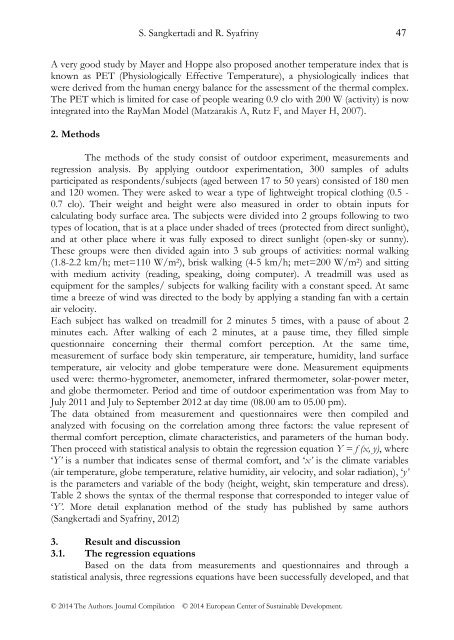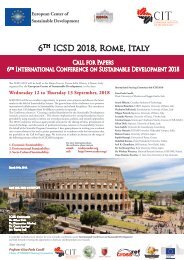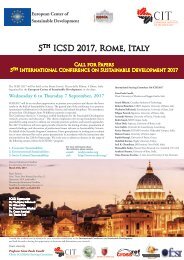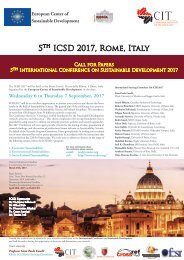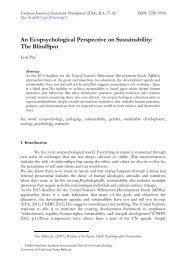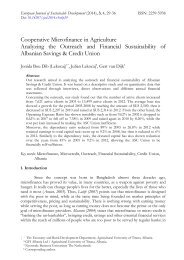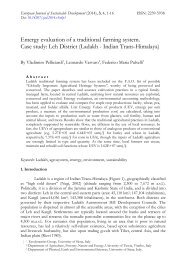European Journal of Sustainable Development (EJSD)
Rome Italy
Rome Italy
Create successful ePaper yourself
Turn your PDF publications into a flip-book with our unique Google optimized e-Paper software.
S. Sangkertadi and R. Syafriny 47<br />
A very good study by Mayer and Hoppe also proposed another temperature index that is<br />
known as PET (Physiologically Effective Temperature), a physiologically indices that<br />
were derived from the human energy balance for the assessment <strong>of</strong> the thermal complex.<br />
The PET which is limited for case <strong>of</strong> people wearing 0.9 clo with 200 W (activity) is now<br />
integrated into the RayMan Model (Matzarakis A, Rutz F, and Mayer H, 2007).<br />
2. Methods<br />
The methods <strong>of</strong> the study consist <strong>of</strong> outdoor experiment, measurements and<br />
regression analysis. By applying outdoor experimentation, 300 samples <strong>of</strong> adults<br />
participated as respondents/subjects (aged between 17 to 50 years) consisted <strong>of</strong> 180 men<br />
and 120 women. They were asked to wear a type <strong>of</strong> lightweight tropical clothing (0.5 -<br />
0.7 clo). Their weight and height were also measured in order to obtain inputs for<br />
calculating body surface area. The subjects were divided into 2 groups following to two<br />
types <strong>of</strong> location, that is at a place under shaded <strong>of</strong> trees (protected from direct sunlight),<br />
and at other place where it was fully exposed to direct sunlight (open-sky or sunny).<br />
These groups were then divided again into 3 sub groups <strong>of</strong> activities: normal walking<br />
(1.8-2.2 km/h; met=110 W/m 2 ), brisk walking (4-5 km/h; met=200 W/m 2 ) and sitting<br />
with medium activity (reading, speaking, doing computer). A treadmill was used as<br />
equipment for the samples/ subjects for walking facility with a constant speed. At same<br />
time a breeze <strong>of</strong> wind was directed to the body by applying a standing fan with a certain<br />
air velocity.<br />
Each subject has walked on treadmill for 2 minutes 5 times, with a pause <strong>of</strong> about 2<br />
minutes each. After walking <strong>of</strong> each 2 minutes, at a pause time, they filled simple<br />
questionnaire concerning their thermal comfort perception. At the same time,<br />
measurement <strong>of</strong> surface body skin temperature, air temperature, humidity, land surface<br />
temperature, air velocity and globe temperature were done. Measurement equipments<br />
used were: thermo-hygrometer, anemometer, infrared thermometer, solar-power meter,<br />
and globe thermometer. Period and time <strong>of</strong> outdoor experimentation was from May to<br />
July 2011 and July to September 2012 at day time (08.00 am to 05.00 pm).<br />
The data obtained from measurement and questionnaires were then compiled and<br />
analyzed with focusing on the correlation among three factors: the value represent <strong>of</strong><br />
thermal comfort perception, climate characteristics, and parameters <strong>of</strong> the human body.<br />
Then proceed with statistical analysis to obtain the regression equation Y = f (x, y), where<br />
‘Y’ is a number that indicates sense <strong>of</strong> thermal comfort, and ‘x’ is the climate variables<br />
(air temperature, globe temperature, relative humidity, air velocity, and solar radiation), ‘y’<br />
is the parameters and variable <strong>of</strong> the body (height, weight, skin temperature and dress).<br />
Table 2 shows the syntax <strong>of</strong> the thermal response that corresponded to integer value <strong>of</strong><br />
‘Y’. More detail explanation method <strong>of</strong> the study has published by same authors<br />
(Sangkertadi and Syafriny, 2012)<br />
3. Result and discussion<br />
3.1. The regression equations<br />
Based on the data from measurements and questionnaires and through a<br />
statistical analysis, three regressions equations have been successfully developed, and that<br />
© 2014 The Authors. <strong>Journal</strong> Compilation © 2014 <strong>European</strong> Center <strong>of</strong> <strong>Sustainable</strong> <strong>Development</strong>.


